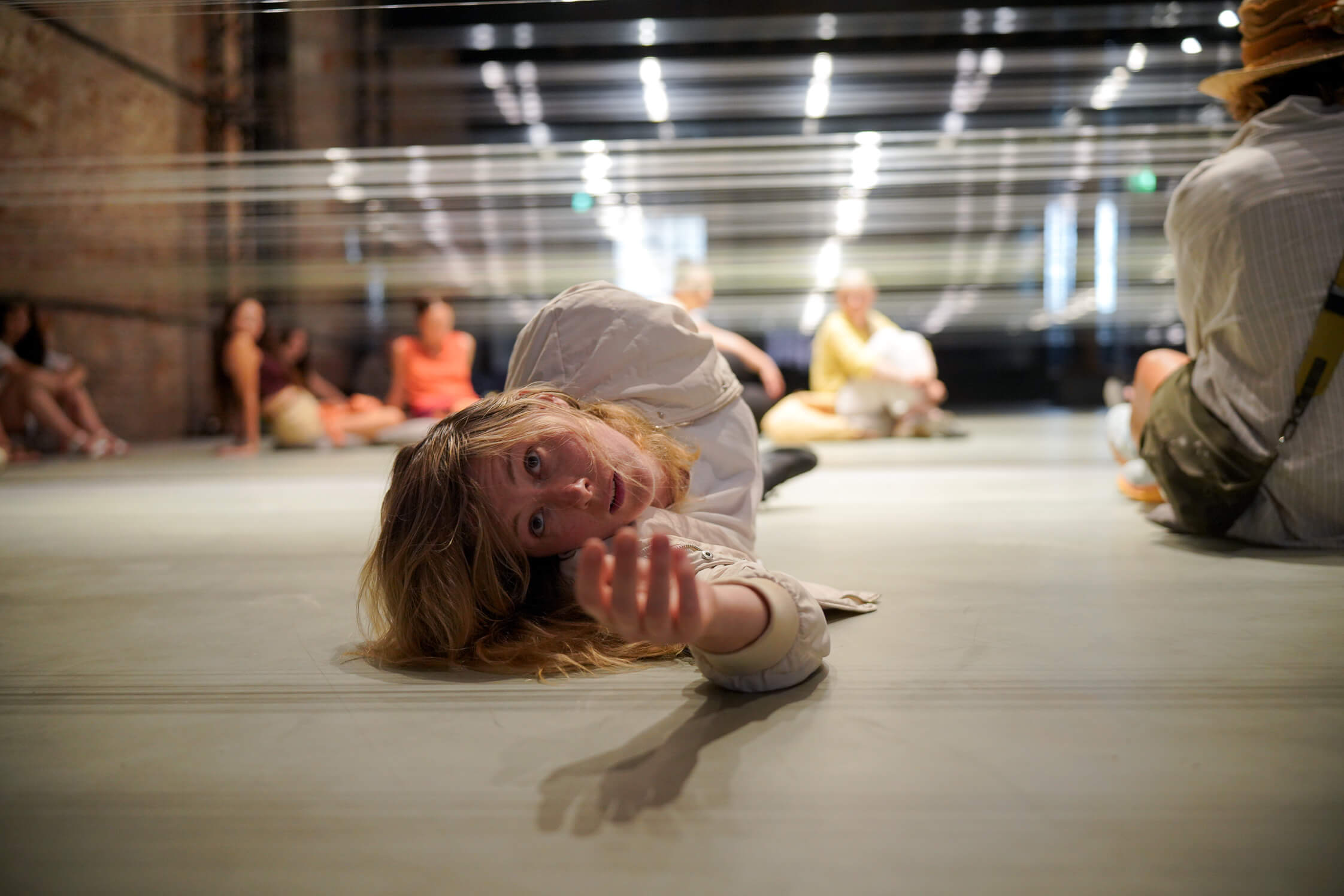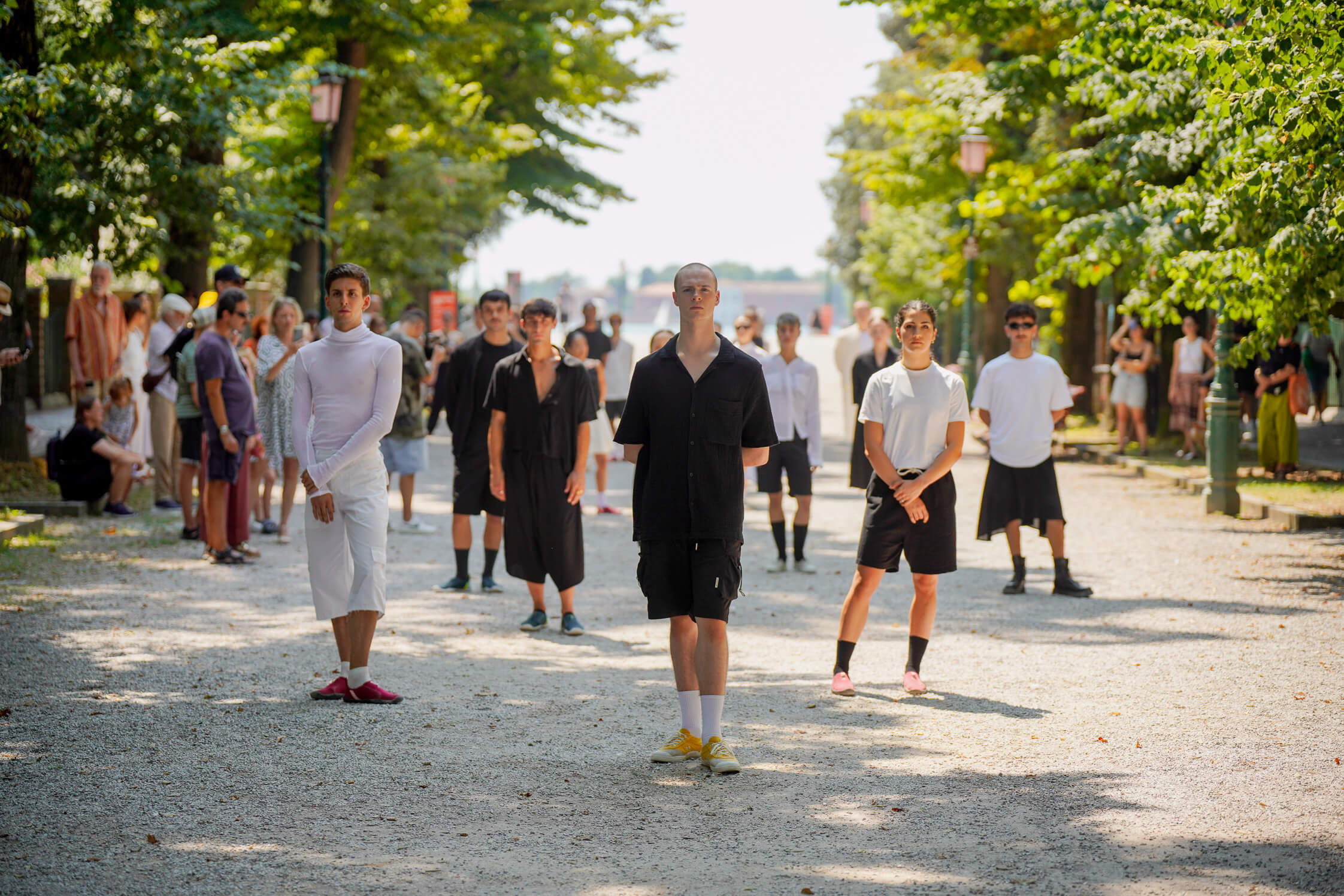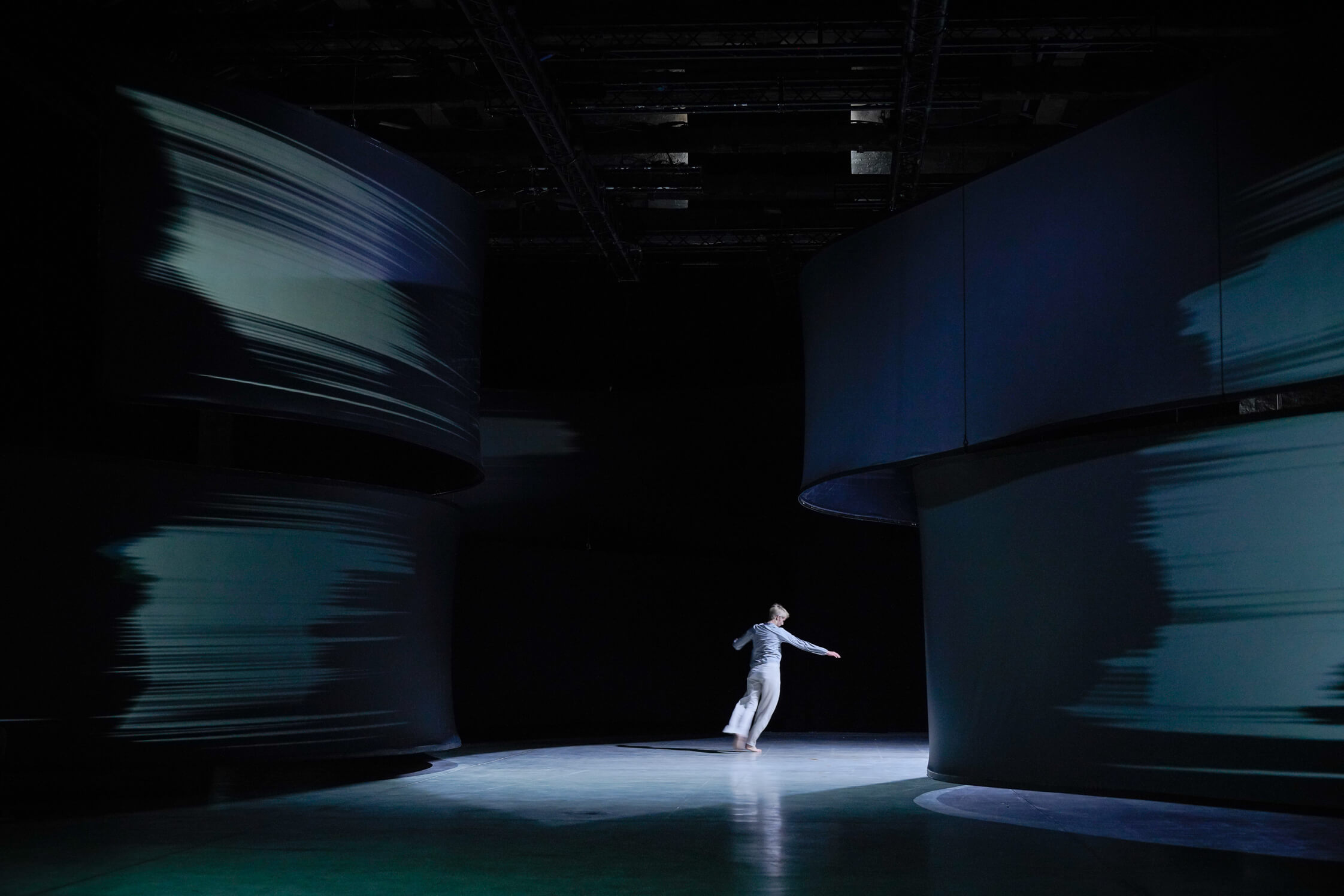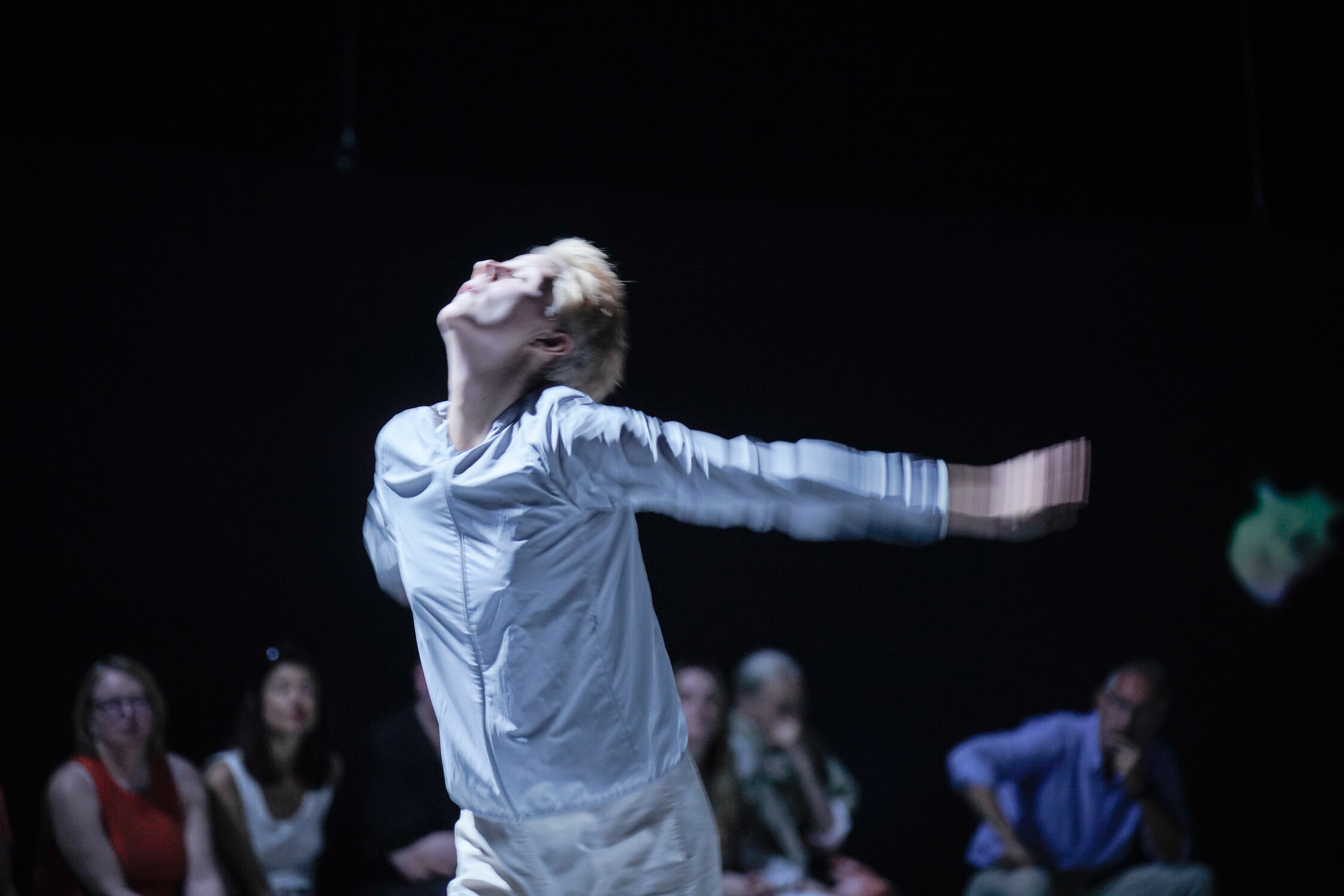The Body that Dances: Reflections on Art and Identity with Cristina Caprioli
Cristina Caprioli
S: Let’s start here, with a brief note about your biography. Can you tell us about your first encounter with dance? What was the spark that made you fall in love with this art, and how has this passion evolved over the years?
C: Even as a child, I had flexibility in my legs and a fondness for fine printed patterns and soft tones. I was serious, restless, and impulsive even then. I invented stories, pretended to be someone else, kept a distance from others, and danced. Even today, dancing is, for me, a way to enter the world without submitting to it and to ‘renounce’ myself in favor of a passion experienced in company. Today, my dance is still the same—a way of being nothing to affirm my existence. A doing-thinking that faces reality using the intangible, that ‘feels’ what it sees, and that lives to ‘grasp’ without needing to possess.
I don’t recall any ‘spark’ or ‘falling in love’. Rather, it was a strong desire and an inclination cultivated over a long time. I started as a child like any other, with exuberant energy but also reserved, and with a distinct predisposition for structured forms, patterns, and schemes. I was ready to lose myself in the contemplation of a gesture or thought, more or less real or imagined. I became a child who found her playground in the dance school. Over the years, dance, which was first a game, a school, and a pastime, has become a life of continuous formation—from passion to trajectory, from extended study to profession, and now all together; my privilege, or rather, my precious obsession, my work. It’s true, I ‘love’ dance, but from a distance and with a long-term commitment. I reached it slowly and from afar; now I circumnavigate it in continuous approximation and cultivated dependence.
That said, many encounters have been significant. Watching Nureyev, Makarova, Baryshnikov (the three great Russians) dance, but especially Fred Astaire, Thom Yorke, and David Bowie, and, of course, Sylvie Guillem and Louise Lecavalier. Folk songs, Gregorian chants, baroque music, hip-hop, pop, rock, and electronic minimalism. Italian neorealism, French films from the 60s, and Hollywood films when they are intelligent. Calvino, Pasolini, Morante, Maraini. Clarice Lispector, Anne Carson. Gerhard Richter, Eva Hesse, the Impressionists, Titian. Zaha Hadid, Renzo Piano. Clearly, post-structural thought and cyberfeminism. There are many, too many. All of them are very important. Without these encounters, my work would not exist, or at least it wouldn’t fill my life.
S: Looking back over your career, which were the most significant moments that led you to become one of the most prominent figures in contemporary dance?
C: More than as an art form, I see my work as the execution of an interest. The interest lies in the way movement makes itself felt and makes us lose our balance. How reality changes and why. Why it remains elusive while making us tangibly present. These simple questions demand a courageous, ingenious, and enduring mobility, ready to leap from the most physically concrete to the uncertain transcendental. A diamond tip in a wide-angle. An in-depth study of sustainable trust.
As I mentioned earlier, my ‘career’ has been a slow becoming, supported by an intrinsic necessity. This is how I am, thoughtful and stubborn. Anxious and exuberant. Methodical, perfectionist. I want to do things well. I give it my all. And that’s how I got here, not to pursue a career, but out of a desire to understand and participate in the present. But if I push myself to answer the question, the most significant moments were the birth and life of my children, my encounter with postmodern dance in New York in the 70s/80s, my artistic collaboration with David, a boy with a neuropsychiatric syndrome, my life in ‘exile’, and my interest in the politics of gesture. But none of this would suffice without the interest and invaluable contributions of my collaborators, thanks to whom each of my works finds its ‘specific form’. And without the directors who have given me the opportunity to act in public. Like in the case of my symposium “Weaving Politics” (2012), the retrospective “Once Over Time” (2022), and now the Golden Lion (2024).

S: The Biennale Danza 2024 opened with a ceremony awarding you the Golden Lion for Lifetime Achievement, recognizing years of work and experimentation that have influenced generations of dancers and choreographers. What does receiving this recognition mean to you, both personally and professionally?
C: First of all, this recognition was a big surprise. Truly unexpected. It almost scared me, it’s so important. And it gave me a lot of strength, made me happy, (temporarily) satisfied, and optimistic. I am so used to working in the ‘undergrowth’ without expectations of ‘success’ that this international public honor caught me in mid-air. I didn’t believe it, and at the same time, I rejoiced. What’s important is that after the initial shock, it led me to reevaluate the capacity and potential of my work. It set it in motion in a new phase, where it no longer needs to explain (bend) itself, justify itself, and defend itself. And even if I will continue to explain it, justify it, and defend it (the work requires it), I will now do so with less timidity. And not alone anymore.
The award legitimizes my work and gives it the right to a place where it can be seen. Consequently, it also recognizes and highlights the work of the entire (like-minded) contemporary dance sector. Many international colleagues congratulated me, friends and colleagues here in Sweden rejoiced, and for a couple of days, instead of uniting in complaints, we embraced each other, celebrating ‘non-conventional’ dance; we truly became collectively proud.
The award has great symbolic value and is the best PR stunt my organization ccap could ever receive. International work opportunities have appeared, and an invitation to Stockholm, but unfortunately no work on a national level. Here in Sweden, in this political moment, the award, like my dance, doesn’t have much significance. After the Biennale, ccap’s activities, and with them my work, are heading toward a very difficult political-economic period. However, none of this undermines my desire or my determination. On the contrary, it strengthens my arguments and actions. These are difficult times. Difficult times must be faced. We must decide how to act. And act with conviction.
Beyond the identity and hierarchical order given by the relationship between the conventional and the innovative, between commercial and immaterial value, the most important questions at this moment are: how does the choreography of our time respond to the current situation? With what arguments can and should dance assert its right to exist, individually and collectively? What actions make the existence of dance indispensable? And where is choreography formed and lived?
We need to refine our arguments, raise the level of our rhetoric, refrain from romanticizing. We must provide and ensure the place and circumstances for a participation that stimulates (enriches). Make available sensory experiences that broaden the common understanding of who a body is, how we move movement, and why movement moves us. Promote movements that dare to speak openly, that respect their participants, and support the encounter of differences. We need to support what surrounds us with aesthetic experiences that add value to the world as we perceive it and cannot yet imagine. And by extension, maintain a counterbalance to the prevailing market-imposed values.
In these hysterical, anxious, neoliberal populist times, politics is unwilling to face the gravity of the current situation. Nothing is being done to update one’s version of reality, formulate a new action plan, trust a new vision. The only thing it does (and vehemently so) is to get rid of the artistic capital that could pave the way for a dynamic change.
Today we need a new description of the purpose of the dance sector and recognition of its potential. Founded on the inclusion of artistic professionals in the field. Based on the desire to initiate change.
It’s time to dance a change. Whether it’s a sanctuary, a mountain cliff, or a two-handed choreography, let dance keep its promise and help us contribute to another ‘here’ and ‘us’.

S: Wayne McGregor was recently reconfirmed as Artistic Director of the Dance Sector of the Venice Biennale for the 2025/2026 biennium. President Pietrangelo Buttafuoco stated, “Wayne McGregor has managed to build a project of great scope for the Biennale Danza, demonstrating an extraordinary sensitivity that closely observes the younger generations on the world stage.” What is your opinion of his work and the direction the Biennale Danza has taken under his guidance? In which direction do you think we should continue working to support a truly contemporary vision of dance?
C: I agree with Buttafuoco; Wayne is a phenomenal, passionate, and effective force. In four years, he has set his vision with great enthusiasm, presenting works of great relevance, opening doors not only to the young but also to the ‘old’ (including myself), showcasing both well-known and lesser-known (foreign?) forms of dance, highlighting different cultures and aesthetics, motives, functions, and different politics and thoughts. Not in terms of ‘diversity’, but rather of multiple values. For this, I am particularly grateful to him. As I am for his work with the College and the new research center project. These are two indispensable initiatives for the future of dance as contemporary art. I am convinced that under his artistic direction, in the next biennium, La Biennale Danza will continue to promote, support, and make contemporary dance accessible in all its spectrum, with all its highs and lows, with critical courage, generosity, intelligence and sensitivity. Ensuring contemporary dance and all of us a significant and dignified future.
S: The theme chosen for this edition, titled “We Humans,” draws on fundamental contemporary research even from a conceptual point of view, aiming to explore our being bodies and being human. Reading the artistic director’s intentions, I thought of the philosopher Emmanuel Levinas, who, in “Totality and Infinity”, explicitly states how each person maintains a relationship with their own body that is both instrumental and constitutive: “We are exactly what we are, since we are the body we possess.” Both near and far, the body offers each of us the experience of the deepest intimacy and the most radical otherness. What is your opinion as a choreographer and experimenter on this matter?
C: Challenging question, which requires two answers.
One is closely related to my work, the other aiming to address a broader scheme of current constraints and conditions.
- This human body of ours, a bearer of culture, capable of articulated language and abstract reasoning, is the central subject of my work. Not that I have a specific interest in humans as such, but rather in their relevance to dance. The issue at stake is dance. How dance moves and how it moves us. From the physiological and kinetic conditions that regulate every movement to the emotional and intellectual enigma that makes us lose our balance, that is, teaches us to ‘dance’; the work is a study in search of both concrete and fleeting evidence. We, dancers in the making, become experts in what dance can dance and what it cannot. However, the work points elsewhere. Places, ideas, circumstances. Forms, structures, tones. Arguments, fantasies. Despite my unconditional love for dance, fascinated as I am by the ingenious engineering of human dance, by the scientific wonders of its execution, and by the set of arguments it carries; it is the self-poetic flow that dance generates that gives purpose to my work. Elastic disorders, transmutative devices, bodies entangled in the disarray of things; in the end, I find myself with a dance “more post-human than human”. Singular in its kind, collective in transit, a dance ready to overstep its conditions, making us participants in a probable here and now.
-
We human beings are a promise in crisis. We (a singular name for plurality) have become a formation easily hijacked to confirm the division between a self-proclaimed “us” and a supposed them/other, while Humans (a plural name that reduces multiplicity to a single species) have become a tribe eager to be seduced, easy to seduce. Quick to fill with contempt and to rage. Unable to be together humanly in mutual respect, We Humans uphold our privilege (refusing to move) while we scream uncontrollably (pretending to move). We Humans do not move. Our promise is nothing but a deceptive slogan.
So? We, arrogant egomaniacs, stereotypical greedy humans, must realize that our ways in the world have come to an end.
From now on, no commentary, representation, or new deceit will suffice. We must reconsider our values, question our beliefs, abandon our alibis, and rethink our purpose. Above all, we must abandon theatricality and start acting. We Humans, faithful dancers, must keep our promise and begin to add something to the world’s conditions. I say, we must dance to understand, believe in art to understand. We must cultivate something, a gesture, an object, a choreography. Keep our commitment and make ourselves different. Hélène Cixous tells us: “Your body is yours; the language is yours, take it.” Let me add: “No body, no language will ever be yours to possess, rather yours to care for and let go.” So, I repeat: Dance a dance if you can’t, spin it hard if you can.” Think carefully, think of it as something beautiful, powerful, weak, and worthy. Listen, respect, allow. Carve a sloping hillside and add some dignity to the world. In what other way could a dance come to be?

S: I would like to recall the schedule of the works presented: “Deadlock”, showcased in Italy for the first time on this occasion; as well as “The Bench”, “SILVER”, and finally “flat haze”. How did you explore the complex theme of the relationship between body and human identity, and how did you interpret it through the choreographies and installations presented at the 18th International Festival of Contemporary Dance? Can we trace a common thread in your creative language?
C: There is a working logic, there is a red thread, albeit in various shades of gray. Despite the continuous turns and the long, convoluted and complex discussions, the creative language has linearity, and if not in chronological order, it progresses. In three layers.
From the flora, fauna, objects, and dismantled cyborgs of “flat haze” (2019), to the laconic figures in “The Bench” (2024), to the empty, bodies of “SILVER” (2022), to the ghostly / phantasmagorical dance of “DEADLOCK“ (2023), I have observed the transformative capacity of the more-than-human human body, affirming the precisione of its gesture in the uncertainty. By highlighting its sign in continuous dissonance with its meaning, the dance continues.
From the centripetal movement residues that sustain a self-illuminated dance, a reflection of its own projection in “DEADLOCK” (2023), to the mute figures that blend with their background, becoming constitutive of the common landscape in “The Bench” (2024), to the subtle layering of the threadlike choreography of “flat haze” (2019), to the aesthetic experience that leads to a participatory collectivity of work and creation in “SILVER” (2022), I have placed choreography in its context, where it works in terms of science, philosophy, and sociality, and from where it offers us critical and poetic value.
From the choreography in itself a haze, within a haze that obscures the view in “flat haze” (2019), to the absence of hierarchies, claims, and sermons, in favor of individually invested time, collectively traced in “SILVER” (2022), from the stalemate / enclosed, inclusive space that induces movement into a continuous return, and therefore also passage / funnel / opening towards a trans-morphology of deviation in “DEADLOCK” (2023), to choreography as an extra-ordinary gesture inserted into the everyday, as a soft-spoken language, present in all its absurd (common) diversity in “The Bench” (2024), I have placed the language of dance in relation to its place of appearance. Questioning the forms, formats, and economies of exchange dictated by conventions. Towards a ‘culture’ that includes dance in the space, tonality, and social conditions in which it occurs.
S: In your opinion, is there a boundary line between dance and other forms of performing arts? In what sense can dance be considered an autonomous art form compared to other artistic expressions? What makes dance, dance?
C: When dance truly dances, it travels far, into itself and into the other.
Not to reposition itself or confirm a career, but for the sake of an imminent/immanent fallout.
I work with/in/through choreography.
The medium of my work is the investigation into how and in what form dance happens.
The aim of the work is a leap into what dance can convey and why.
Brainwaves and interwoven parasympathetic synapses. Electrochemical signals on call. Ganglionic neurons in a frenzy. Control and trusting abandonment. Reflected image and self-reflection at the same time. A gesture that is recognized and left unknown.
Continually running through bodies, languages, imagination, and matter. Jumping from one to another, retracing the same that is already different. Watching from afar, ready to maintain the necessary distance to recognize those minimal differences that make a shared commonality possible. A self-reflective process, moving toward the self-evidence of inclusive disinterest. For the love of a dance already foreign to itself, forever coupled with the other. The self and the ‘other’ intertwined, as if it were an unmade cyborg, ‘she’ (to me, dance is a ‘she,’ ‘there’) surpasses the normative binary and connects to the third, the many, the all. Multiple by choice, singular in essence, confident in its blend, collective in its “fallouts.”
The sheer and simple idea of a non-anthropocentric and non-phallocentric choreography is astonishing.
Upright without a backbone, I would like to/we shall dance.

S: Looking to the future: is there a particular message you would like to leave for young dancers and choreographers who look to you as a source of inspiration?
I would encourage them not to rush, not to seek immediate gratification. And to choose their calling.
Have faith in what you like, in what you want to do, in what stimulates you the most, what gives you purpose, even if you don’t understand why.
Prepare for a life of work. Beautiful, but tough. It requires intelligence, perseverance, and desire.
And then dedicate yourself to one thing at a time, and invest all the time that this ‘one’ thing requires.
They must learn to swallow/include everything but also to filter every impression.
To always be critical but never cynical, to ruminate on everything for a long time and then regurgitate the stupidities, even if they are beautiful or dominant.
Above all, I would like them not to underestimate dance, its meaning, and its potential. To live/study it in scientific, intellectual, poetic, and transformative terms. For the benefit of an aesthetic, tangibly physical experience. But also trans-linguistic, intra-disciplinary, vague and relevant.
When will you be able/need to make use of your choreography?
When you have known everything that you hold, when you have taken a step forward without realizing what you have done. When the operation is in progress, and the intention is established, when the work has its strategy of creation for creation, when other actions and operations lead you to other intentions and performances. When your work has set platforms of work, from which you can see the entire registry of the format already determined and that which has been erased or is yet to be determined. When your motivation, function and outcome have begun to collaborate. When the work started is concluded without the situation being resolved. When every movement that surfaces gains awareness (knowledge?) and removes a productive disorder. When choreography performs through its movement. When dance truly dances, regardless of whether in step with or in counterpoint to your own step.
How to translate and elaborate socio-political experiences, ideas, abstract reasonings into the physical body?
By entering into the thing/movement/dance itself at the moment of its action, to dig there, recognize, see, and allow. Only to immediately ‘transport’ what has been experienced into the arms and legs, torso, pelvis, nerve fibers, surrounding space and its constraints. Supporting a critical approach to all activities undertaken, surrendering to the reality of circumstances. All this guides the process of a type of work that trusts in a choreography that affirms but also reconsiders the place, time and context from which this particular dance emerges and simultaneously re-binds itself to/embeds in this particular choreography. Physical bodies, psychological states, cerebral movements that make themselves constitutive of their here and now. Real and imaginary.
With what should/can your work contribute?
Long-term investigative artistic projects through artistic social assistance, interactive meeting places, workshops, laboratories, internships. A stimulating workplace, a rewarding work environment, repeated work opportunities, access to sensorial, physically tangible and imaginary experiences, welcoming yet challenging. Introduction of inclusive exchange economies suggesting choreography in various formats, well-curated, that do not seek to convince you but rather offer a dance that awakens your senses and touches you deeply.
“models and forms, lines of thoughts and tones
aesthetic experiences, not necessarily useful
non-consumable experiences
from afar, in the intimate
an infectious condition
an approach”
Good luck!




